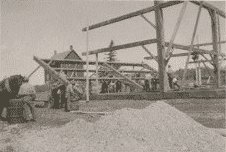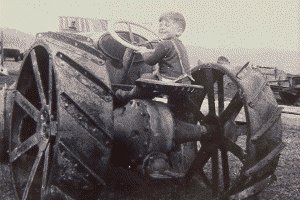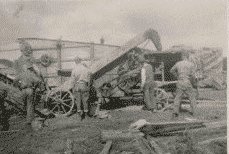|
Back to Settlements Introduction Overview Church School Hall Transportation Everyday Life |
Carved In Granite: Agriculture in the Kynoch Valley
The topography of the Mississagi River Valley is not very conducive to farming, as it is very hilly and rocky. Yet the early settlers managed to carve out farms wherever there was reasonably level, fertile land. In the Kynoch Valley, the clearing of land for farmland started in 1886. Using cross-cut saws and axes, two of the first pioneer men cleared ten acres and built a cabin in six months. By 1888, families were starting to move into the valley. Spring and summer were spent raising crops and clearing land on the new homesteads. Clearing land was done by cutting and burning, a process which sometimes had disastrous consequences if the fire wasn't watched carefully. In the winter the men worked in the lumber camps to provide their families with a source of income. The lumber camps also provided a market for the farmers' produce - hay, grain, beef, pork, turnips and potatoes were all purchased by the camps for the men and horses. When the market for spruce pulpwood opened up, the farmers were able to sell the wood they cleared off of their farmland, thus earning some extra income. By 1895 crops were starting to take hold. The area was beginning to develop into one which would sustain farming. Horses were replacing the oxen, which the farmers had used up until then. 
The extent to which people depended upon their neighbors helped to create a sense of community. Without the help of neighbours, many residents could not have lasted through the early years of the settlement. 'Bees' were a very popular way of getting things done and strengthening community and neighbourly bonds. A barn raising 'bee' was an event which most members of the community attended, all helping out one of their own. Prior to a barn-raising bee, the farmer would get all parts of the barn cut, mortised and tenoned and ready to be put up. Timbers and beams were hewn by hand. A gang of men would come and put the barn up in a day. In the early days, as now, a good neighbour was a valuable asset. Originally, all harvest was done by hand with scythe and grain cradle. The first advancement of farm technology in the valley came in 1898 when the first mower and horse drawn rake was purchased. The farmers continued to advance in technology, albeit slowly. In the 1950's, many were still using horses, although tractors were starting to appear. 
The speed of technological advancement is checked by two deciding factors: the desire, and the ability to change. For many farmers, cost is the deciding factor in how quickly they will adopt the newest technology. Both factors are evident in the fact that while some harvest with combines, others still use binders. It is a reflection of the diversity of the farming community in the valley. 
The Kynoch Valley, since the time of settlement, has mainly been a farming community. In the early days, farmers worked their farms in the summer and worked in the lumber camps in the winter. To this day, few farmers in the valley are able to support their families solely on the income made through farming. Return to Top |
Home | Natural Environment | History | Industry | Personalities/Stories | Credits/Team